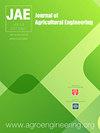Hydrologic performance assessment of nature-based solutions: a case study in North-eastern Italy
IF 2.4
4区 农林科学
Q2 AGRICULTURAL ENGINEERING
引用次数: 0
Abstract
The consequences of climate change are exacerbated by land-use changes, which influence the rainfall-runoff relations and consequently the flood risk. Effectively, urbanization is steadily contributing to the increase of impervious areas and reducing the time-to-peak. The effect of Nature Based Solutions (NBSs) on the mitigation of these phenomena is recognized. Nevertheless, these kinds of sustainable infrastructures are still barely known and scarcely adopted in many parts of the European Countries. The LIFE BEWARE project aims to enhance hydraulic safety and spread good practices in rainwater management by promoting and facilitating the adoption of NBSs in the Altovicentino area (Northern Vicenza Province, Veneto Region, Italy). To support the dissemination activities, some full-scale NBSs have been created within the municipality areas involved in the project. The hydrological impact of the structures is continuously monitored thanks to the installation of devices measuring inlet and outlet runoff, and rainfall pattern. This study aims to analyse the monitoring data of the first two years of the built NBSs. Results show that the structures managed almost all the water runoff through processes of infiltration and retention, providing additional insights into understanding the real behaviour of NBSs exposed to the specific environmental conditions of a very rainy foothills area. In particular, mean rain intensity and rainfall duration are the variables that mostly affected the structure performance, especially for events prolonged over time (2-3 days) with mean rainfall intensity in the range of 2-3 mm/h. Therefore, the overall outcomes from this analysis resulted as being useful to improve the design of NBSs and further promote their installation in urban areas.基于自然的解决方案的水文性能评估:意大利东北部的案例研究
土地利用变化加剧了气候变化的后果,影响了降雨-径流关系,从而增加了洪水风险。实际上,城市化正在稳步推动不透水面积的增加,并缩短了到达峰值的时间。认识到基于自然的解决方案对缓解这些现象的影响。然而,这些可持续的基础设施在欧洲国家的许多地方仍然很少为人所知,也很少采用。LIFE谨防项目旨在通过在Altovicentino地区(意大利威尼托大区维琴察省北部)推广和促进nss的采用,加强水力安全,传播雨水管理的良好做法。为了支持传播活动,在参与项目的城市地区内建立了一些全面的国家统计局。由于安装了测量入口和出口径流和降雨模式的设备,因此可以持续监测结构的水文影响。本研究旨在分析已建成的国家统计局前两年的监测数据。结果表明,这些结构通过渗透和保留过程管理了几乎所有的水径流,这为理解nbs暴露于多雨丘陵地区特定环境条件下的真实行为提供了额外的见解。特别是,平均降雨强度和降雨持续时间是影响结构性能的主要变量,特别是随着时间的推移(2-3天),平均降雨强度在2-3毫米/小时范围内的事件。因此,该分析的总体结果有助于改进nbs的设计,并进一步促进其在城市地区的安装。
本文章由计算机程序翻译,如有差异,请以英文原文为准。
求助全文
约1分钟内获得全文
求助全文
来源期刊

Journal of Agricultural Engineering
AGRICULTURAL ENGINEERING-
CiteScore
2.30
自引率
5.60%
发文量
40
审稿时长
10 weeks
期刊介绍:
The Journal of Agricultural Engineering (JAE) is the official journal of the Italian Society of Agricultural Engineering supported by University of Bologna, Italy. The subject matter covers a complete and interdisciplinary range of research in engineering for agriculture and biosystems.
 求助内容:
求助内容: 应助结果提醒方式:
应助结果提醒方式:


